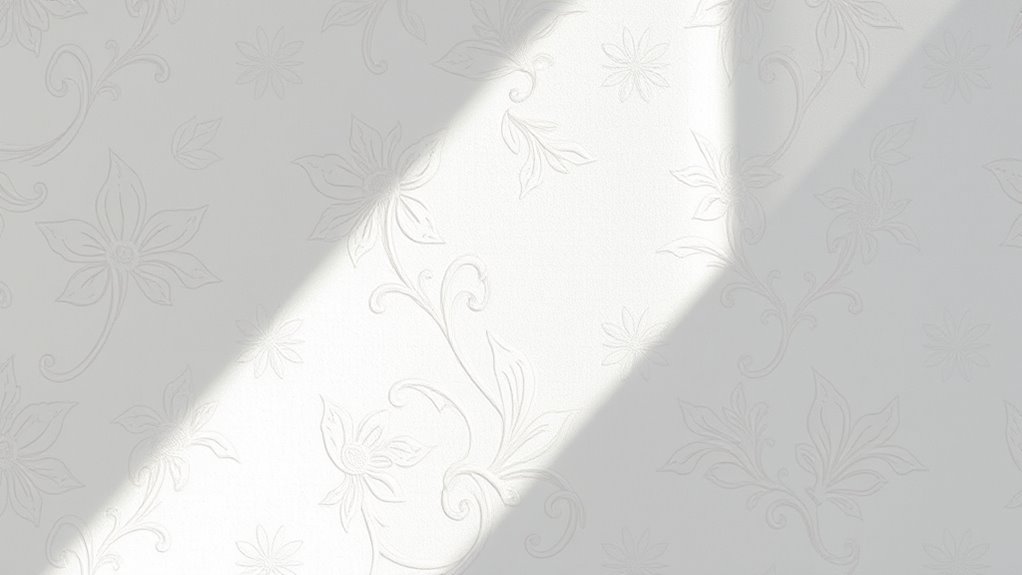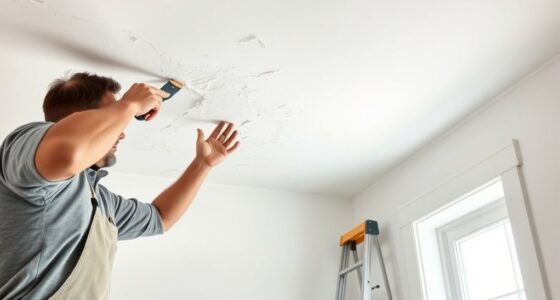Using removable adhesive wallpaper is a smart way to personalize your rental space without risking wall damage or your security deposit. Make sure the walls are clean and smooth before application, and follow the manufacturer’s instructions carefully. This type of wallpaper peels off easily without leaving residue or damaging paint, helping you protect your walls and that essential deposit. Keep going to learn more tips for a successful and stylish rental upgrade.
Key Takeaways
- Use removable adhesive wallpaper to prevent wall damage and protect your security deposit.
- Properly prepare walls by cleaning and smoothing surfaces before application.
- Follow manufacturer instructions carefully to ensure easy removal and minimize residue.
- Measure and align wallpaper accurately for a neat appearance and to avoid unnecessary rework.
- Test a small section first to ensure compatibility and easy removal without damaging paint.

Are you wondering if wallpaper is a feasible option for rental spaces? The good news is, it can be, especially if you choose the right type and approach. Many landlords prefer removable adhesive wallpapers because they don’t require harsh chemicals or damaging adhesives that could harm the walls when you move out. These wallpapers are designed to peel off easily, leaving behind minimal residue and helping you avoid costly repairs or paint touch-ups. Before you get started, though, proper wall preparation is essential. You want to make sure the surface is clean, dry, and smooth. Remove any dust, grease, or flaking paint, and consider lightly sanding the wall to create a better surface for the wallpaper to adhere to. This step ensures the wallpaper stays in place and reduces the risk of bubbles or peeling over time. Utilizing imagination to visualize the final look can also help you plan your design and placement more effectively.
Choosing removable adhesive wallpaper and proper wall prep makes rental decorating easy and damage-free.
Using removable adhesive is a game-changer when it comes to decorating rental spaces. Unlike traditional wallpaper paste, removable adhesives are designed to stick firmly but come away easily when it’s time to remove or change the wallpaper. They’re especially handy because they minimize wall damage, which is a top concern in rental situations. When applying wallpaper with removable adhesive, take your time to measure and align your panels carefully, ensuring a smooth finish. Carefully peel back the backing and stick the wallpaper to the prepared wall, smoothing out air bubbles as you go. Many removable wallpapers are also repositionable during installation, giving you a little wiggle room to perfect your placement.
Wall preparation is often overlooked but is critical to a successful wallpaper project in a rental. Even if you’re using a peel-and-stick product, a clean and smooth surface will give you the best results. If your walls have imperfections, filling in holes or cracks with spackle and then sanding the surface smooth will help. It’s also a good idea to test a small section first, especially if you’re unsure how the wallpaper will interact with your wall’s finish. When you’re ready, apply the wallpaper, making sure to press out any air pockets and align the edges carefully.
Ultimately, using removable adhesive wallpaper paired with proper wall preparation allows you to personalize your rental space without risking your deposit. It’s a simple, affordable way to upgrade your living area temporarily and remove it cleanly when your lease ends. By taking a little extra time to prepare and choose the right adhesive, you can enjoy a stylish space that feels like home without the stress of permanent changes.
Frequently Asked Questions
Can I Remove Wallpaper Without Damaging the Paint Underneath?
Yes, you can remove wallpaper without damaging the paint underneath by using gentle wallpaper removal techniques. Start by scoring the wallpaper lightly, then apply a mixture of warm water and mild soap to loosen the adhesive. Always check paint compatibility considerations beforehand; some paints may peel or bubble. Use a putty knife carefully to peel away the wallpaper, and work slowly to avoid damaging the paint beneath.
What Types of Wallpaper Are Safest for Rental Properties?
Choose removable, peelable wallpaper for rental properties, as they’re safest for your walls. These wallpapers use gentle adhesives, making removal techniques easier without damaging paint. Look for material durability—vinyl or fabric-based options—because they resist tearing and peeling, which helps protect your deposit. When applying, avoid harsh adhesives or heavy-duty removal methods. Stick with peelable wallpapers for a seamless, damage-free experience, ensuring your walls stay pristine during your tenancy.
How Do I Ensure My Deposit Isn’t Forfeited After Wallpaper Removal?
To guarantee your deposit isn’t forfeited after wallpaper removal, follow proper wallpaper removal tips like gentle peeling and using safe removal solutions. Document the process with photos and keep receipts for any supplies. Use deposit protection strategies such as restoring the wall to its original condition, patching holes, and repainting if needed. These steps demonstrate your effort to return the space to its initial state, helping you secure your deposit.
Are There Eco-Friendly Options for Temporary Wallpaper?
Imagine transforming your space with vibrant, eco-friendly wallpaper that leaves no lasting mark. You can find biodegradable wallpaper that’s perfect for temporary decorating, and eco-friendly adhesives that hold securely yet cleanly peel away. These options are gentle on the environment, ensuring your rental stays pristine while you enjoy stylish updates. With biodegradable wallpaper and eco adhesives, you create a beautiful, sustainable space that’s easy to change and kind to the planet.
Can Landlords Refuse Permission for Wallpaper Installation?
Yes, landlords can refuse permission for wallpaper installation, especially if it conflicts with painting restrictions or requires wall preparation that could damage the property. They have the right to set rules to protect their walls and deposit. Before you proceed, always ask for approval, and make sure you understand any restrictions on wall modifications. This helps avoid disputes and potential deductions from your deposit later.
Conclusion
So, as you choose wallpaper for your rental, remember it’s more than just decoration; it’s a safeguard for your deposit and the paint beneath. Sometimes, the right choice feels like a lucky coincidence—an unspoken harmony between your style and the space’s needs. When you take care with your wallpaper, you’re not just protecting walls, but also creating a home where little surprises, like a spotless deposit or a fresh start, can happily align.








